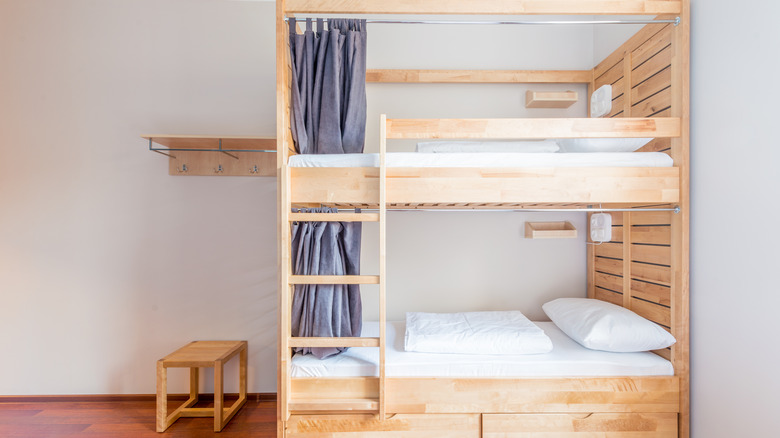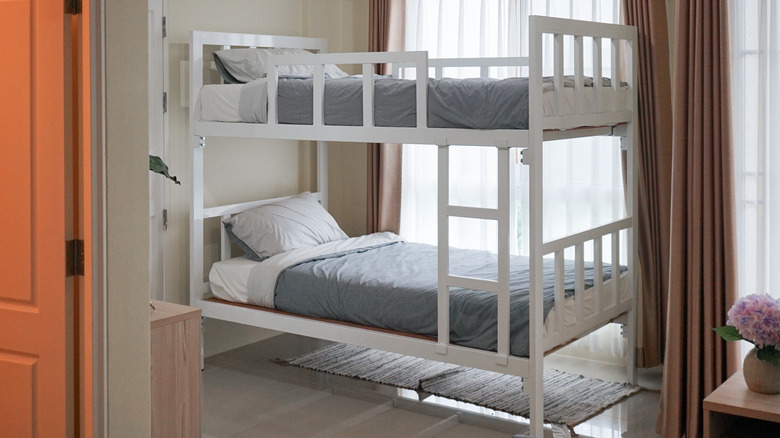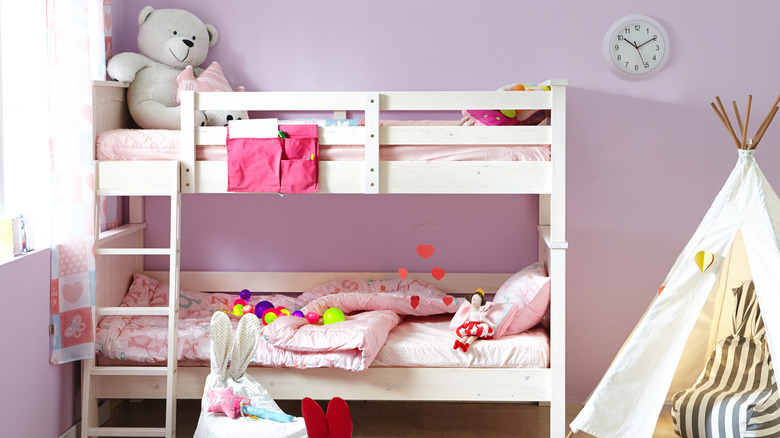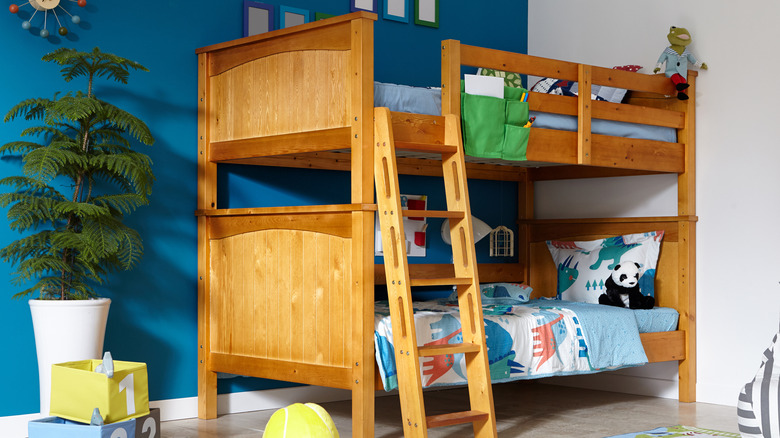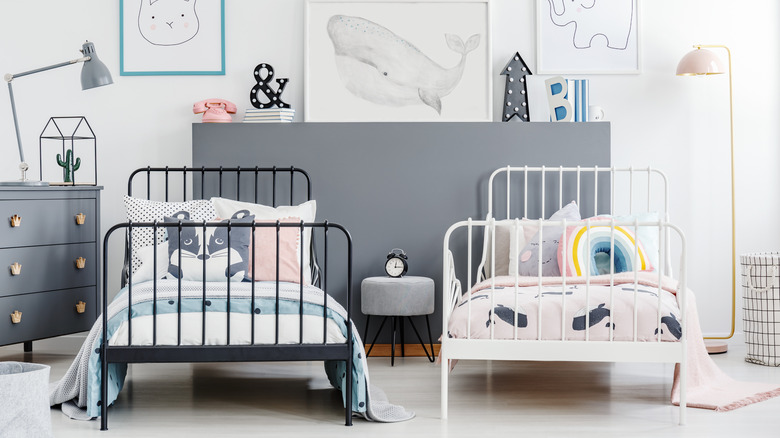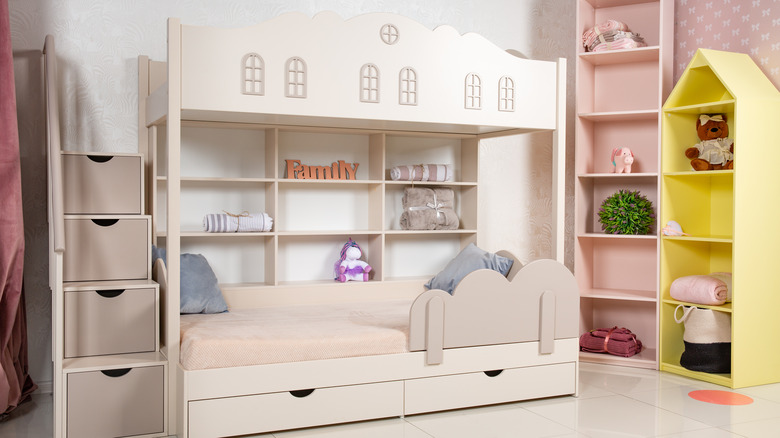5 Tips For Choosing The Right Bunk Beds For Your Space
Bunk beds can be so much more than just a floor-saving solution. They could also be the reason your kids have a fun childhood experience. According to Kids Only Furniture, children love bunk beds because they make every night feel like an adventure. They make kids feel like they're sleeping in a fort, especially if a blanket is wrapped around the bottom bunk. Additionally, they can help siblings that share a small bedroom feel like they each have their own space.
If you're thinking about adding a bunk bed to your children's bedroom or a guest room, you're likely researching for advice to pick the right one. There are a number of styles, sizes, and unique features to choose from. Thinking about your specific needs will help you avoid feeling overwhelmed by the thousands of options you could choose. Below are five tips for choosing the right one for your space.
1. Choose the ideal material and setup
There are myriad bunk beds to choose from in a number of different styles, colors, and setups. You may want to begin by deciding the material. According to Custom Kids Furniture, most bunk beds are made from either metal or wood. While metal is durable and inexpensive, most people don't prefer the look, and it may not be as comfortable. Wood is more expensive but also looks chic in a space.
Next, you'll need to decide how you want the beds to be set up. Homedit says the standard configuration is two twin beds stacked on top of each other. However, you could also choose larger mattresses, like fulls or queens. Or, you could even have a larger mattress for the bottom bunk and a twin for the top bunk.
Other options include a triple bunk bed, which has three twin beds stacked on top of each other. Some triple styles only have two levels but come in an L-shape, to fit into the corner. Trundles are the standard style with an extra bed that can be pulled out from underneath the bottom bunk. A futon bunk has a couch underneath a twin. Or, you could choose a loft, with only one bed above and empty space underneath.
2. Consider the size and height
After deciding on the material and setup, you can consider the size. The size will largely be determined by the beds you chose, whether twin or larger. However, you could also choose a uniquely sized bed. For instance, you could choose XL twin beds, which add five inches to the length of the mattress (via Eachnight). This would be ideal for tall children. There are also XL full mattresses. Or, if you have small kids, you could get a shorty bunk with shorter mattresses, as Mattress Nut explains.
Another important consideration is height. You'll want to make sure your ceilings are high enough so that your kids don't hit their heads when sitting up in bed. According to Mattress Nut, standard bunk beds are 50 to 65 inches tall, but some can even be higher than 77 inches. Of course, those with three beds will be higher than those with two. To ensure the child on the top bunk doesn't hit their head, allow 33 to 38 inches between the ceiling and the top of the mattress.
3. Decide on stairs or a ladder
To get up to the top bunk, your children will need to either use stairs or a ladder. There are three types to choose from: a straight ladder, an angled ladder, or a staircase. Each option has its own pros and cons. According to Matrix Kids, a straight ladder is the most common and least expensive, but also the least safe option. Angled ladders are safer but take up more floor space. A staircase is the safest option but also the most expensive and takes up the most space.
To determine what option is right for your kids, think about how much room you have and how concerned you are about safety. You'll also need to consider comfort. The easiest and most comfortable option is a staircase. If you choose a ladder, make sure the rungs are large enough. Bunk Bed King also notes you should consider the age of your kids. Younger children may have a more difficult time climbing up and down a ladder. Additionally, it's important to ask your kids what they feel most comfortable using.
4. Determine if you want beds that separate
While most bunk beds can't be disassembled into their own beds, some can. To take them apart, Mattress Nut says you'll first need to remove the mattresses, the safety rail, and the ladder.
There are a number of benefits to choosing beds that can be taken apart. As Bunk Bed King explains, it may be useful in the future if your children will one day get their own rooms. This will keep you from having to buy new beds. It also makes the design of a room more flexible.
If desired, you could disassemble the beds permanently, which would create a whole new design in the space. Mattress Nut also says children who have grown too tall for the top bunk may need their beds disassembled, so they don't hit their heads on the ceiling. If your bunk bed is in a guest room, you could take apart the beds when adult guests stay over.
5. Think about storage options
Some bunk beds also come with extra storage options. This could be a great space saver in a small room. Bed and mattress store Happy Beds notes that extra storage is one of the best advantages of bunk beds. Many models with staircases have stairs that open up into compartments that are perfect for storing small items like toys or clothes.
According to Swiss Valley Furniture, bunk beds can also be made with built-in bookcases, drawers, or dressers. These could be on the side of the bunk or underneath the bottom bed. When a dresser or bookcase is built into the side of a bunk, the top bed will lay against the wall as normal while the bottom bed will have its pillows against the wall.
Additionally, you could choose to purchase a loft design that only has a bed on top and empty space beneath. This would provide you with the perfect opportunity to place a chest of drawers or a desk (with storage) underneath the top bunk.
